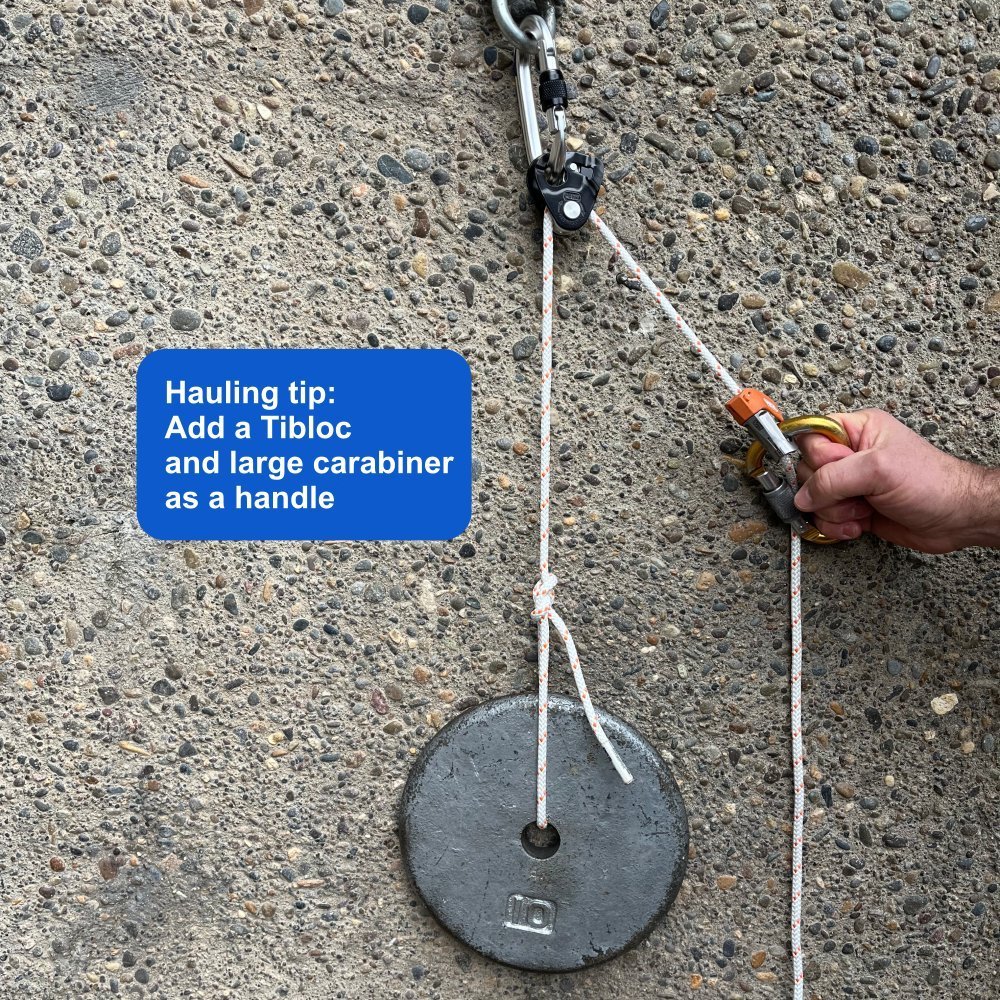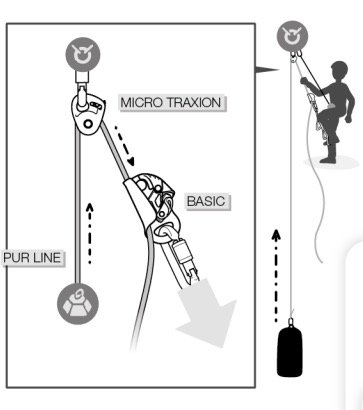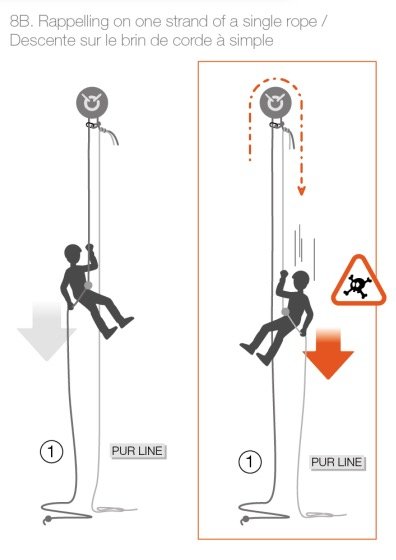Petzl - RADline vs PURline comparison
Petzl offers two flavors of highly specialized ropes for alpine climbers: the RADline and the PURline.
What's with the acronyms?
Can I lead climb on ‘em? (Quick answer, NO!)
Are they both basically the same thing?
Can I really use a 6 mm rope for something practical, or is this a dog leash?
They both have a lot of similarities and some important differences, so let's get into it.
Similarities of RADline and PURline
Both are hyperstatic (just 2% stretch!) and NOT meant for lead climbing.
Both are 6 mm.
Both have a core of HMPE (High Modulus Polyethylene), commonly known as Dyneema. This makes them very strong (12 kN RADline, 15 kN PURline) and cut resistant.
Because of the HMPE core, these ropes absorb essentially zero water, so they're much lighter when dragging through the snow.
Both have a sheath that’s bonded to the core, which means you can use them for hauling with ascenders, such as a Tibloc, Micro/Nano Traxion progress capture pulleys, and even larger ascenders, see diagram.
The ascender/pulley compatibility may be confusing, because the technical documentation for the Tibloc and Traxions specify a minimum rope diameter of 8 mm. Apparently it's fine to use these devices on these 6mm lines. Petzl says that these ropes can take about a 4 kN load with these devices before the sheath will be damaged. See Petzl test results on this here. (Summary: Use a Traxion on RADline only.)
Because of the small diameter, both are highly prone to tangling. Using some sort of rope bag is highly recommended. If you don't have a rope bag, coiling it with a daisy chain (aka chain Sinnet or crochet) works pretty well too. If you tie the bottom end of the rope to your rope bag, you can toss it for rappel and quickly deploy the rope perfectly, even in high winds.
A basic nylon stuff sack works okay as a rope bag. However, it’s difficult to stuff the rope in a floppy bag. Here I’m using an ice screw bag made by High Mountain Gear. It's the perfect size, has a lid that stays open for rope stuffing, has a couple of attachment points, is extremely sturdy, and works great as rope bag.
RADline details
Intended use: crevasse rescue, glacier travel and rappelling.
Made for “Rescue And Descent”, hence the name.
Static ropes can be great for glacier travel, provided you have excellent rope management, i.e., minimal slack. Because it's static, the distance of any fall will be minimized - less rope stretch. On the downside, because it's static, if the people on top have extra slack out, it can give them a powerful yank. If using this rope for glacier travel, be very mindful of distance between partners and watch your slack.
Weight: 22 grams per meter (about half the weight of an 8mm dynamic rope)
It has a rougher sheath for better handling, more friction on ice and snow when arresting falls, and for extra friction when rappelling.
It's a bit more supple, which makes it a bit easier to handle and to stuff into your pack.
It's orange, which gives better contrast on snow.
Rappelling on this is easier than the PURline, but still can be challenging because of the small diameter. Definitely learn some techniques to increase friction, such as shown in this article. You also use specialized rappel devices made for small diameter ropes such as the Black Diamond ATC Alpine guide, Grivel Scream, or the Edelrid Mago 8 (see below).
I tested using an 6mm Edelrid Aramid cord as a four wrap prusik on both ropes. This held my body weight on the RADline, and not on the more slippery PURline. A Tibloc may be better choice than a prusik on rope this thin.
Comes in lengths of 30 and 60 meters.
Supposedly has a 10 year rated lifespan, which is longer than the typical dynamic rope.
Sorry, no nice diagrams from Petzl. =^(
The Grivel Scream is one of the few devices rated for ropes between 5 and 8 mm. If you are a ski mountaineer and plan on doing lots of rappelling on a RADline, this might be a good one to get. (Note, I don’t have one of these and I've never tried it. I love the name!)
image credit: Grivel
Another rappel device option is the Edelrid Mago 8. This is a modified figure 8 with a few extra horns on it, similar to rappel devices popular for canyoneering. This device is rated for ropes from 6mm to 9.5mm. (Note, I don’t have this device and I've not tried it.)
image credit: Edelrid
PURline Details
Intended use: rappel retrieval/tag line or haul line.
Made of “PURre” Dyneema, hence the name.
Weight: 20 grams per meter, a hair lighter than the RADline (about half the weight of an 8mm dynamic rope)
The PURline is both slippery and stiff, which makes it easier to pull over rock and a bit less prone to tangles when you're using it as a rappel tagline. Surprisingly durable.
It's white, which gives it better visibility on rock.
Because it's so slippery, rappelling directly on it with a standard device is not recommended, even if you take extra steps to add friction. A super Munter might work. (Don't even think about rapping with a Grigri on one strand of PURline.)
When used as a tagline, Petzl recommends using TWO stacked opposed overhand knots to join the ropes. The standard flat overhand bend is NOT recommended, see diagram below.
Hopefully obvious, but when used as a tagline, you should rappel on your normal climbing rope of a larger diameter, and only use the PURline to pull the rope down, see diagram below.
NOTE: Rappelling on a Reepschnur / knot block, and two ropes of different diameters, opens up LOTS of concerns and considerations, more than I can get into here. Definitely practice in a controlled environment with a qualified instructor before you ever do it for real.
Rappel tip with a tagline like this: thread both strands through your rappel device, as this can help remove twists as well as keep the tagline attached to you. (That’s the one strand you need to pull, so you NEVER want to let the tagline swing/blow out of your reach!)
The PURline comes in lengths of 65 meters and 200 meters. Does 65 meters sound like a strange length? It did to me, until I learned that the clever Petzl gear gnomes chose this to account for the dynamic stretch of a typical 60 meter rope that you're using it with. (And that 200 meters? Maybe that's for fixing lines on K2 or something.)
Hauling tip: If you're hauling a load or pulling down a rappel tagline, a small diameter rope is slippery and rough on your hands. Here's a quick tip: add a Tibloc, Micro Traxion or similar ascender onto the hauling side and clip a large carabiner to it as a handle. It’s much easier on your hands!
Best use: hauling and rappel pull cord.
image credit: https://www.petzl.com/INT/en/Sport/Ropes/PUR-LINE-6-mm
For hauling, the PURline is compatible for with the Petzl Mini/Micro Traxion (and even larger ascenders like the Basic or Ascension.)
image credit: https://www.petzl.com/INT/en/Sport/Ropes/PUR-LINE-6-mm
Caution: rappel on the larger, blocked strand of rope.
PRACTICE using knot blocks and retrieval cords with a qualified instructor before ever using them for real! There are lots of ways to screw this up!
image credit: https://www.petzl.com/INT/en/Sport/Ropes/PUR-LINE-6-mm
Caution: Petzl says to use a stacked, opposed overhand to connect the two ropes. Flat overhand bend is not recommended, figure 8 bend definitely not recommended.
Petzl has a very detailed article on their website about recommended knots to use in RADline. The short version: flat overhand bend or stacked overhand is recommended. Have rope tails of at least 30 cm and dress/ snug down the knot very well.
image credit: https://www.petzl.com/INT/en/Sport/Ropes/PUR-LINE-6-mm










